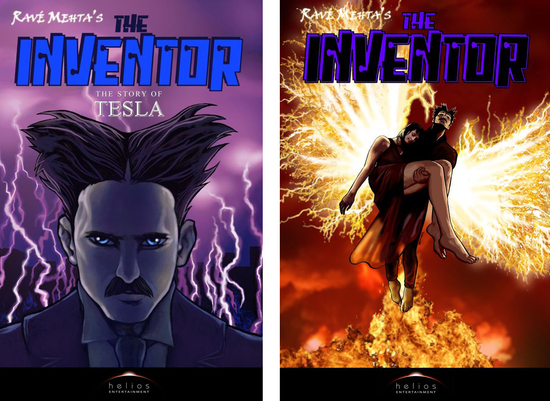Comic books and video games may seem out of place in a science classroom, but these hyper-visual and unintimidating tools may hold the key to inspiring more students to pursue STEM careers.
Despite its surplus of technological jobs, the United States has been consistently lagging in the rankings for science and math education and failing to produce the science, technology, engineering, and math (STEM) experts its needs. Most recently, the United States ranked 43rd in math and 33rd in science, behind Singapore, Japan, and Hong Kong who consistently lead the way.
So, what is America doing wrong? More and more, educators are pointing the finger at poor teaching methods and outdated technology. Whereas students now have the ability to access visually rich media like TED Talks, Snapchat, Pinterest, and more from their smart phones, older text-heavy books and non-interactive teaching is insufficient to engage students in content. In fact, recent research demonstrates that of undergraduates who leave STEM majors, 98% of them cite poor teaching methods as a primary concern.
The push for reformed and more visual curriculum is not coming from students alone. Rather, advancing visual technologies may just be the catalyst for implementing long-standing research on learning techniques and memory. Visual learning, particularly in STEM, can have numerous benefits including opening new ways to solve problems and enhancing communication of complex ideas. Visual memory is often thought to be advantageous over other forms of memory as well, so once ideas are learned through visual methodologies, they have the potential to remain with students for longer periods of time.
Visual Approach to Learning
Now, drawing on decades of research and increasing social pressures, teachers are leading a revolution to improve the retention of STEM students and increase engagement with more visual and more applied learning methods.
Whereas the super heroes of yesteryear were able to teach previous generations about gravity, the genome, and more, teachers today are taking the initiative to design their own comic books for their lessons. Ravé Mehta, an engineer and author, reflected on his own childhood love of comic books when writing his wildly popular comic book The Inventor: The Story of Tesla. Mehta’s The Inventor introduces students to numerous STEM topics relating to the second industrial revolution, and teachers and students alike love it! After its introduction in 2012, the comic has sold more than 30,000 copies, and Mehta is now planning on expanding the series to include other influential science and technology role models.
Mehta is not alone in his beliefs that using tools like graphic novels will drastically improve STEM education; other educators and policy makers are also taking note and embracing this updated and highly visual approach. Luen Yang, a former computer scientist and author of the coding graphic novel Secret Coders, was just selected by the Library of Congress to serve as the USA’s National Ambassador for Young People’s Literature. Yang is the first graphic novelist to be selected to fill this role. Similarly, the National Science Foundation just completed its first „Generation Nano: Small Science, Superheroes“ competition in which high school students could submit videos or comics that show off superheroes using nanotechnology enabled gear.
STEM Video Games
While comic books undoubtedly serve as one way to make STEM more appealing to students everywhere, video games serve as a second option to engage an enormous audience and increase user involvement in learning. Whereas less that half a million U.S.-based students graduated with STEM degrees between 2000 and 2005, engaging online games including World of Warcraft boasted over 10 million subscribers. Admittedly, World of Warcraft is not an educational game, but the disparity cannot be blamed on content alone. Food Force, a United Nations-produced game on the mechanics of food aid delivery and Whyville, a K-12 science and math education game, both report 4 million users. Interestingly, 8 to 14 year old girls are the predominant demographic in Whyville users, a stark contrast to the lack of women in STEM today. Advances in video game technology has allowed for a diverse set of educational games to be developed already, with topics ranging from immunology to numerical methods.
These games are not just piquing the interest of students by luring them in with the false sense of fun. Educational video games that are designed well (and like traditional teaching methods, not all are designed well) draw on the wealth of knowledge in cognitive neuroscience, learning techniques, and behavioral sciences.
Video games can easily incorporate key educational concepts like spaced-repetition, the notion that learning is deeper and longer-lasting when reinforced over time instead of being crammed in before an exam, and concurrent-chaining, when ideas are built upon incrementally instead of being delivered at once. Moreover, with rewards, leveling-up, and special prizes, learners are gaining immediate feedback and gaining self-confidence, which in turn translates to greater persistence and an overall higher level of achievement. The interactive video game environment can be significantly efficacious than traditional lectures in a number of ways. A recent review of 6 different video games across middle school and college showed that student-learning incomes increased between 7 and 40%. For students who were previously struggling, video games also provided a self-paced environment to catch up; in River City, an ecology game, the learning gap between D- and B-level students was diminished so that all students were performing at the B-level.
Although there are numerous positive examples of how comic books and video games can help support the next generation of STEM students, the jury is still out on all of the benefits gained from these techniques. Plus, like any other educational methods, there is no substitute to quality; as with lectures and textbooks, comic books and video games that are insightful and well thought out are likely going to be more impactful than those that are poorly carried.
The next time you hear a student struggling with STEM, encourage them to check out the latest in STEM comic books and video games instead of hitting the text books again.




















